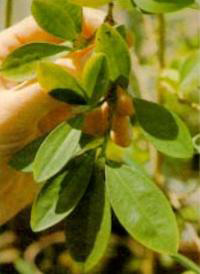 |
 |
 |
 News from Around the Americas | June 2006 News from Around the Americas | June 2006  
Colombia Sees Rise in Coca Growth
 BBC News BBC News


| | The active ingredient of the coca plant was first isolated in the West by the German chemist Friedrich Gaedcke in 1855; he named it “Erythroxyline”. Albert Niemann described an improved purification process for the PhD; he named it “cocaine”. Sigmund Freud, an early enthusiast, described cocaine as a magical drug. Freud wrote a song of praise in its honour and he practised extensive self-experimentation. To Sherlock Holmes, cocaine was “so transcendentally stimulating and clarifying to the mind that its secondary action is a matter of small moment”. Robert Louis Stephenson wrote The Strange Case of Dr. Jekyll and Mr. Hyde during a six day cocaine binge. Intrepid polar adventurer Ernest Shackleton explored Antarctica propelled by tablets of ‘Forced March’. |
Coca production in Colombia grew by 8% in 2005 - the first rise in five years, the UN Office of Drugs and Crime says.

The production of coca, the raw material for cocaine, reached 86,000 hectares last year, UNODC found.

Despite the rise, it is half of Colombia's cultivation in 2000, which then stood at 163,000 hectares.

Colombia needs more international help to find alternative livelihoods for ex-coca farmers, one of the report's authors, Anja Korenblik, said.

Since 2000, the United States has spent more than $4bn on the fight against drug-trafficking in Colombia.

This has involved the aerial spraying of herbicides to kill the crops, as well as by law enforcement.

But despite such eradication efforts, the area under coca cultivation in Colombia rose by 6,000 hectares between 2004 and 2005, UNODC found.

Beating the cartels

"In Colombia in 2005, we found 86,000 hectares of coca bush, that is an 8% increase on 2004 when we saw 80,000 hectares," Mrs Korenblik told the BBC's Americas Service.

"That's almost half of the cultivation in the year 2000 when it was more than 160,000 hectares so it's really an impressive decline."

But she said the research showed more economic aid was required for poor farmers who grow coca on behalf of the drug cartels.

"What is needed is for the international community to support Colombia in identifying alternative livelihoods for ex-coca farmers," she said.

"This is not happening enough and that's probably why it's difficult for all the Andean countries to sustain their reductions in coca cultivation that they have seen," she added.

Colombia remains the world's largest producer of cocaine, although its share has dropped to 54% from 74% in 2000.

Coca production in Peru and Bolivia fell by 8% and 4% respectively in 2005, UNODC found. | 
 | |
 |



